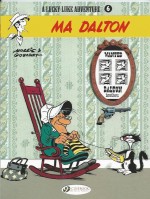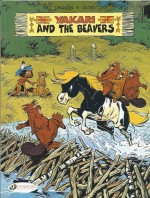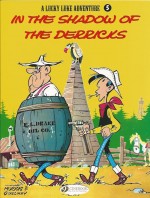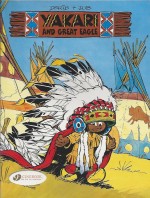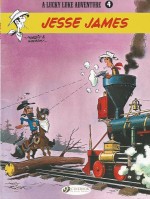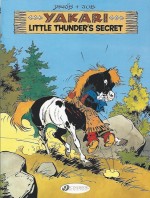
By Derib & Job, coloured by Dominque and translated by Jerome Saincantin (Cinebook)
ISBN: 978-1-84918-223-2
Win’s Christmas Gift Recommendation: Astounding Spectacle with a Potent Message… 9/10
Children’s magazine Le Crapaud à lunettes was founded in 1964 by Swiss journalist André Jobin who began writing for it under the pseudonym Job. Three years later he hired fellow French-Swiss artist Claude de Ribaupierre who had begun his own career as an assistant at Studio Peyo (home of Les Schtroumpfs), working on Smurfs strips for venerable weekly Spirou. Together they created the well-received Adventures of the Owl Pythagore before striking pure gold two years later with their next collaboration.
Launching in 1969, Yakari detailed the life of a little Sioux lad on the Great Plains; sometime after the introduction of horses by the Conquistadores but before the coming of the modern White Man.
Abundantly packed with gentle whimsy, the beguiling strip celebrates a bucolic existence of noble wanderers in tune with nature and free of strife, punctuated with the odd crisis generally resolved without fame or fanfare by a little lad who is smart, compassionate, valiant… and can converse with all animals…
As “Deribâ€, de Ribaupierre – equally excellent in both the enticing, comically dynamic “Marcinelle†cartoon style and with devastatingly compelling meta-realistic action illustration – went on to become one of the Continent’s most prolific and revered creators through such groundbreaking strips as Celui-qui-est-né-deux-fois, Jo (the first comic on AIDS ever published), Pour toi, Sandra and La Grande Saga Indienne).
Many of his stunning works over the decades feature his adored Western themes, built on magnificent geographical backdrops and epic landscapes, and Yakari is considered by most fans and critics to be the feature which primed the gun. With the boldly visual story under review here, the steady transition to his more epic milieux has never been more evident…
Le secret de Petit Tonnerre was first released as a European album in 1981 and became Cinebook’s 12th Yakari volume in 2014, but that won’t be a problem for chronology or continuity addicts as the tale is both stunningly simple and effectively evergreen; easily accessible and welcoming for young kids and/or their adult minders meeting the bold little Brave for the first time…
It all begins one bright sunny day as Yakari races in a fever of excitement through the Arcadian landscape on his faithful steed Little Thunder: both equally lost in a joyously exhilarating paroxysm of speed and excitement, running to the max just because they can…
Once they have pushed themselves to their physical limits, the weary, jubilant friends return to camp and Little Thunder joins the corral for the night, but when morning comes and the lad rushes to greet his beloved pony again Yakari experiences a shocking sight…
Little Thunder is gone and none of the other horses can tell him where the wonder-horse has gone. Heartbroken and scared the forlorn lad searches the camp and scours the surrounding countryside, but his best friend has vanished without trace…
Miles away the superb stallion is pressing on, gripped by an uncanny instinctive urgency to follow an ancient route far out into the desert. Narrowly avoiding capture by human hunters from another tribe, Little Thunder relentlessly advances, meeting other magnificent horses also overcoming ferocious hardships to gather in a distant place for an incredible rendezvous.
Meanwhile back in the village, Yakari is setting out to search for his missing friend, accompanied by another pony eager to help in what might be a long and hazardous quest. Their tracking is assisted by helpful prairie dogs who chatted with Little Thunder when he passed. None have any idea why the pony was so determined, only that his mission was one of tremendous importance…
Far, far ahead, the arduous journey and increasingly brutal terrain have winnowed out all but the fittest and most determined equine pilgrims. Eventually the trek even forces Yakari and his new four-footed companion to turn back, but Little Thunder and a few other horses push on, resolved to complete their meeting with destiny.
Eventually the hardiest survivors arrive on a strange plain and as the sun sets they are hailed by a staggeringly beautiful black stallion: the Spirit of the Horse People…
The gathered herd are the latest to have been called to “The Rock of the Hoof†to undergo the four lethally testing trials which will transform them into the acme and pinnacle of what horses can aspire to be. The ritual has been held since time immemorial and only the greatest amongst them will succeed and survive…
The epic undertaking further diminishes the gathering and those who triumph are changed forever.
Some time later Little Thunder trots back into Camp but can say nothing of his obvious ordeal. Yakari doesn’t mind: he is ecstatic that his greatest friend has returned and although he is burning to know where he went and what caused the fresh scars that mar that beautiful hide. He is content to accept that the events must always be Little Thunder’s Secret…
Visually captivating and edged with fearsome tension, this a potently compelling mystery which favours thrills and chills over laughs but remains happily heart-warming: Job’s mystical plot allowing Derib another unmissable opportunity to prove his astonishing mastery of mood, scene and action-illustration by crafting a powerful fable of trust and friendship, unafraid to show youngsters that not every story is without tragedy and triumph often comes at a price…
The exploits of the valiant little voyager who speaks to animals and enjoys a unique place in an exotic world is a decades-long celebration of marvellously moving and enticingly entertaining adventure, honouring and eulogising an iconic culture with grace, wit, wonder and especially humour.
These gentle sagas are true landmarks of comics literature and Yakari is a strip no fan of graphic entertainment should ignore.
Original edition © Derib + Job – Editions du Lombard (Dargaud- Lombard s.a.) 1981, 2002. English translation 2014 © Cinebook Ltd.


